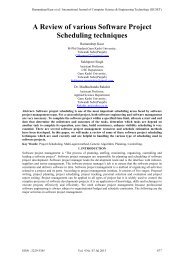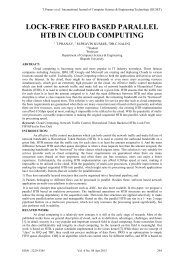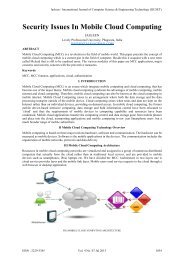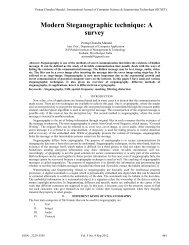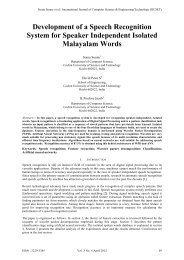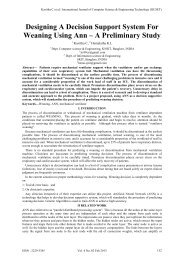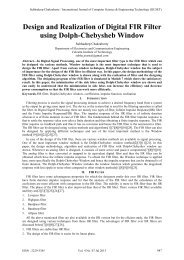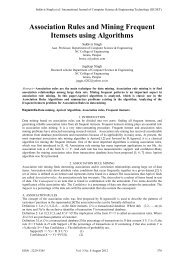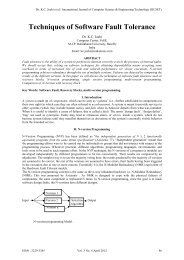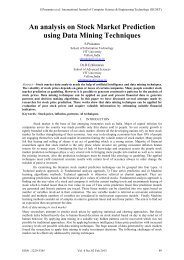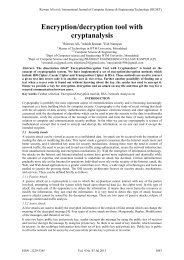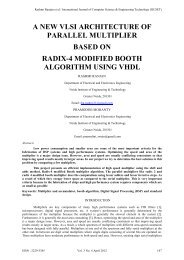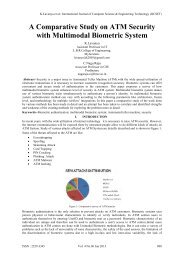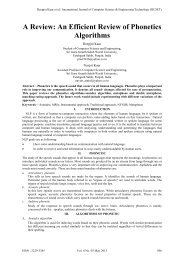a non-linear scheme for pmepr reduction in mc-cdma system - IJCSET
a non-linear scheme for pmepr reduction in mc-cdma system - IJCSET
a non-linear scheme for pmepr reduction in mc-cdma system - IJCSET
Create successful ePaper yourself
Turn your PDF publications into a flip-book with our unique Google optimized e-Paper software.
S.Tamilselvan et al./ International Journal of Computer Science & Eng<strong>in</strong>eer<strong>in</strong>g Technology (<strong>IJCSET</strong>)Figure 7 BER per<strong>for</strong>mances of each iterationOn consider<strong>in</strong>g the correspond<strong>in</strong>g BER per<strong>for</strong>mances on an ideal additive white Gaussian noise (AWGN)channel, still with an envelope clipp<strong>in</strong>g as the <strong>non</strong><strong>l<strong>in</strong>ear</strong> operation. As expected, the required Eb/N0 decreaseswhen clipp<strong>in</strong>g level is <strong>in</strong>creased, and the BER per<strong>for</strong>mances with are already close to the correspond<strong>in</strong>gper<strong>for</strong>mances with <strong>in</strong>f<strong>in</strong>ite users. However, <strong>in</strong>creased values of subcarriers imply a higher PMEPR, i.e., an<strong>in</strong>creased power amplification backoff.Figure 6 shows the BER <strong>for</strong> each iteration <strong>in</strong> comparison with required/conventional BER per<strong>for</strong>mance. Theoptimum values of clipp<strong>in</strong>g level are 2.0 <strong>for</strong> 4, 2.6 <strong>for</strong> 16, and3.2 <strong>for</strong> 64QAM.Moreover, these optimum values of clipp<strong>in</strong>g levels are almost <strong>in</strong>dependent of the frequency-doma<strong>in</strong> filter<strong>in</strong>gef<strong>for</strong>t. When not consider<strong>in</strong>g the iterative procedure analyzed <strong>in</strong> chapter 3, where the signal-process<strong>in</strong>g cha<strong>in</strong> isrepeatedly used which leads from to peak amplitude clipped pulses, so as to provide an additional <strong>reduction</strong> ofthe envelope fluctuations while preserv<strong>in</strong>g a compact spectrum.From the Figure 7, the BER per<strong>for</strong>mance of MC-CDMA with this <strong>reduction</strong> technique reaches theconventional MC-CDMA per<strong>for</strong>mance of <strong>for</strong> <strong>in</strong>creased no. of iteration and degradation <strong>in</strong> SNR.V. CONCLUSIONS AND FUTURE RESEARCHIn this work, a problem experienced <strong>in</strong> the OFDM modulation technique <strong>in</strong> the MC-CDMA <strong>system</strong> has beenstudied. The various multiple access techniques that were common <strong>in</strong> modern communications <strong>system</strong>s are<strong>in</strong>troduced. OFDM modulation was <strong>in</strong>troduced which was a specific <strong>for</strong>m of multiple access technique based onFDMA and also discusses how OFDM modulation operates and commences the advantages and disadvantagesof the modulation <strong>scheme</strong>. The PAPR problem that is commonly experienced <strong>in</strong> MC-CDMA signals was<strong>in</strong>troduced provid<strong>in</strong>g the motivation <strong>for</strong> an effective solution.Consequently a wide class of digital signal-process<strong>in</strong>g <strong>scheme</strong>s <strong>for</strong> MC-CDMA transmission which comb<strong>in</strong>ea <strong>non</strong><strong>l<strong>in</strong>ear</strong> operation <strong>in</strong> the time doma<strong>in</strong>, and a <strong>l<strong>in</strong>ear</strong> filter<strong>in</strong>g operation <strong>in</strong> the frequency doma<strong>in</strong> was presentedand evaluated. The ultimate goal of these <strong>scheme</strong>s is to reduce substantially the envelope fluctuation of ord<strong>in</strong>aryMC-CDMA <strong>system</strong>, while keep<strong>in</strong>g its high spectral efficiency and allow<strong>in</strong>g a low-cost, power-efficientimplementation.A detailed evaluation of MC-CDMA signal transmission techniques which employ the signal-process<strong>in</strong>g<strong>scheme</strong>s considered here was carried out, <strong>in</strong>volv<strong>in</strong>g computations of power spectra, BER per<strong>for</strong>mances, andachieved PMEPR values. Such evaluation has taken advantage of our statistical characterization of thetransmitted blocks and <strong>in</strong>cluded other implementation issues (such as the impact of the time-w<strong>in</strong>dow<strong>in</strong>gprocedures). A set of per<strong>for</strong>mance results was presented and discussed, show<strong>in</strong>g that the proposed basic<strong>scheme</strong>s can provide a significant PMEPR <strong>reduction</strong> while keep<strong>in</strong>g a high spectral efficiency.The iterative technique based on the basic <strong>scheme</strong>s was shown to allow a further PMEPR <strong>reduction</strong>, alsoma<strong>in</strong>ta<strong>in</strong><strong>in</strong>g the spectral efficiency of conventional MC-CDMA, with only a moderately <strong>in</strong>creasedimplementation complexity. When compared with other distortionless techniques, also capable of reduc<strong>in</strong>g thePMEPR of MC-CDMA signals, these signal process<strong>in</strong>g techniques <strong>in</strong>volv<strong>in</strong>g deliberate <strong>non</strong><strong>l<strong>in</strong>ear</strong> distortionwere shown to offer improved per<strong>for</strong>mance/complexity tradeoffs, <strong>for</strong> small constellations and a high number ofsubcarriers.The <strong>non</strong>- <strong>l<strong>in</strong>ear</strong> signal process<strong>in</strong>g <strong>scheme</strong> has been used to test narrowband and broadband pulses conclud<strong>in</strong>gthat broadband pulses were far superior <strong>in</strong> reduc<strong>in</strong>g PMEPR. Numerical results demonstrate that improvementsISSN : 2229-3345 Vol. 3 No. 3 March 2012 20



